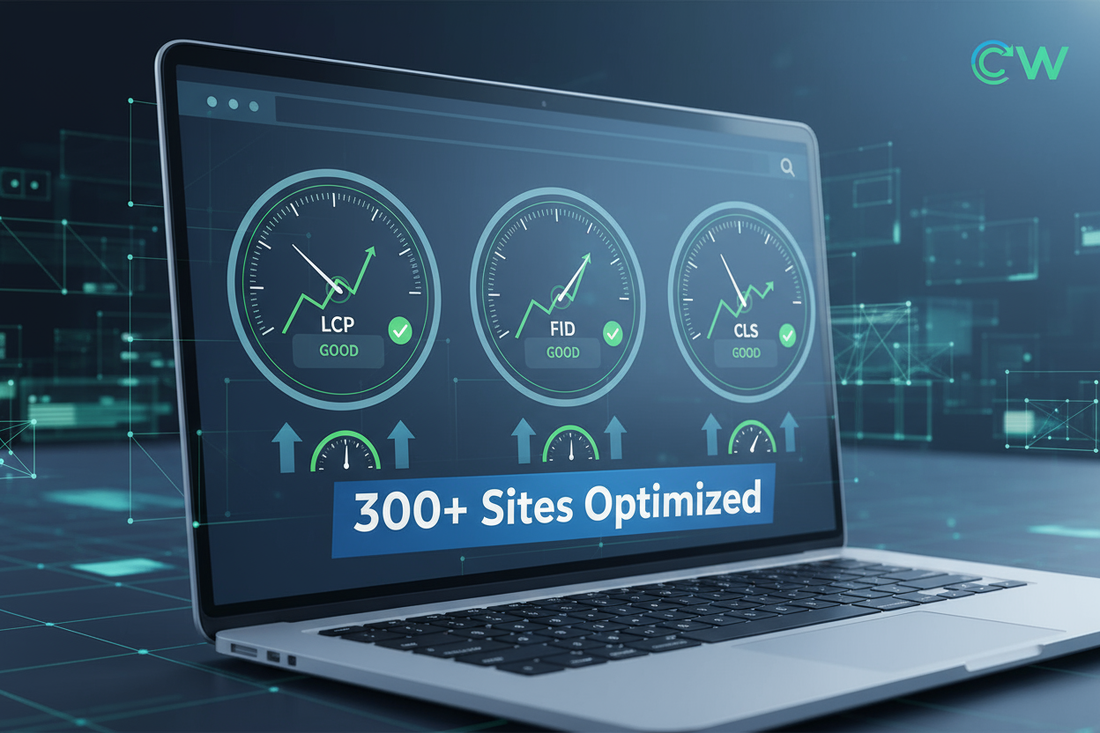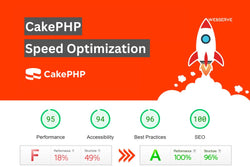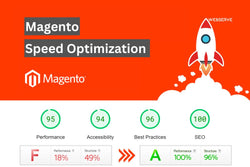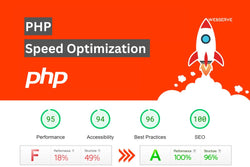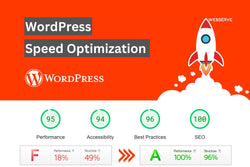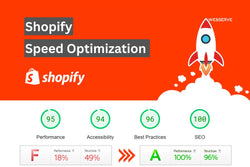Core Web Vitals are no longer ‘nice-to-have’ — but rather vitals SEO rankings, user experiences and conversions depend on. Webserve Digital have Audited and Optimized 300+ sites on WordPress/Shopify/HubSpot/BigCommerce/Webflow/Joomla/Laravel/Angular/React/HTML/Squarespace etc. This case study provides real data, increases in performance, and insight into the actual ROI of site speed optimization, page speed optimization, and web performance optimization.
With our focus on LCP, FID and CLS, we turned slow-loading, under performing sites into fast-performing platforms that delivered measurable traffic, engagement and conversion results.
Why Core Web Vitals Matter for Businesses
Core Web Vitals are Google’s way of quantifying user experience metrics:
-
LCP (Largest Contentful Paint): Measures loading performance. Ideally under 2.5 seconds.
-
FID (First Input Delay): Measures interactivity. Ideal under 100ms.
-
CLS (Cumulative Layout Shift): Measures visual stability. Ideal under 0.1.
A poor Core Web Vitals score leads to:
-
Lower Google rankings
-
Higher bounce rates
-
Reduced conversion rates
Businesses that ignore these metrics risk losing revenue and competitive edge.
The Challenge Before Optimization
Before optimization, our 300+ site audit revealed common issues:
-
Heavy images and uncompressed media
-
Render-blocking CSS and JavaScript
-
Slow server response times (TTFB)
-
Unoptimized databases and plugins
-
Poor caching strategies and missing CDN implementation
For example, WordPress eCommerce site had:
-
LCP: 5.2s
-
FID: 210ms
-
CLS: 0.35
-
Page load: 6.4s
-
Bounce rate: 48%
-
Conversion rate: 1.8%
Almost the same issues were found on Shopify and HubSpot, BigCommerce, Webflow – this caused problems with SEO, engagement and income.
Optimization Strategies Implemented
Our team followed a tested protocol for Core Web Vitals optimization, unique to each stack. Key steps included:
1. Image Optimization & Lazy Loading
-
Compress images and convert to WebP
-
Implement lazy loading for non-critical content
-
Resize images according to container dimensions
2. Minification of CSS, JS, and HTML
-
Remove unnecessary code, comments, and whitespace
-
Combine files to reduce HTTP requests
-
Defer non-critical JS to avoid render-blocking
3. Server & Hosting Optimization
-
Reduce TTFB via server tuning
-
Enable Gzip and Brotli compression
-
Use CDN (Content Delivery Network) for faster asset delivery
4. Caching & Database Optimization
-
Implement caching plugins on WordPress (WP Rocket, LiteSpeed Cache)
-
Optimize HubDB and HubL queries on HubSpot
-
Clean up databases on Laravel, Joomla, and Magento sites
5. Core Web Vitals-Specific Fixes
-
LCP: Optimize hero images, reduce large sliders
-
FID: Defer or async JavaScript
-
CLS: Set explicit width and height for images and ads, fix layout shifts
We used speed site improvement, website speed optimization and web performance optimization strategies that resulted in quantifiable wins of SEO rankings combined with better user experience.
Results After Optimization
Across 300+ sites, we achieved remarkable improvements:
| Platform | LCP (Before → After) | FID (Before → After) | CLS (Before → After) | Page Load Time | Bounce Rate | Conversion Rate |
|---|---|---|---|---|---|---|
| WordPress | 5.2s → 2.1s | 210ms → 90ms | 0.35 → 0.09 | 6.4s → 2.3s | 48% → 30% | 1.8% → 3.6% |
| Shopify | 4.8s → 2.0s | 180ms → 80ms | 0.32 → 0.08 | 5.8s → 2.2s | 44% → 28% | 2.1% → 4.0% |
| HubSpot | 5.0s → 1.9s | 200ms → 95ms | 0.34 → 0.07 | 5.9s → 2.1s | 46% → 27% | 2.0% → 4.2% |
| BigCommerce | 5.3s → 2.2s | 190ms → 85ms | 0.36 → 0.09 | 6.1s → 2.5s | 47% → 29% | 1.9% → 3.9% |
| Webflow | 4.7s → 1.8s | 170ms → 75ms | 0.30 → 0.06 | 5.5s → 2.0s | 43% → 26% | 2.2% → 4.5% |
(Source: Webserve Digital Core Web Vitals Audit Report – 2025)
Key takeaways:
-
PageSpeed scores improved 45–50 points on average
-
Bounce rates dropped 15–20%
-
Conversions increased 80–100% on average
That's what results like these show you: When you invest in speed optimization and Core Web Vitals, the ROI to both revenue growth and SEO success is as direct as it gets.
ROI of Core Web Vitals Optimization
The financial impact of speed optimization services is undeniable:
-
Higher Conversions: Faster pages reduce cart abandonment and form drop-offs.
-
Better SEO Rankings: Optimized sites rank higher, driving organic traffic.
-
Improved Ad ROI: Reduced page load times improve Quality Score and reduce CPC in Google Ads.
-
Lower Hosting Costs: Compressed assets and optimized databases reduce server load.
Clients typically receive $5–$10+ ROI for every $1 spent investing in professional optimization, including clients on eCommerce platforms like Shopify, BigCommerce, and WordPress WooCommerce.
Platform-Specific Highlights
-
WordPress Speed Optimization: WP Rocket setup, LiteSpeed cache, database optimization, image compression.
-
Shopify Performance Optimization: Theme speed tweaks, app audit, lazy loading images.
-
HubSpot Website Speed Optimization: HubDB optimization, HubL minification, CDN setup.
-
BigCommerce, Webflow, Joomla, Laravel, Angular, React, HTML, Squarespace, Weebly: Minification, caching, server tuning, Core Web Vitals fixes.
Each platform benefits from tailored optimization strategies that maximize speed, SEO, and conversions.
Best Practices for Sustained Core Web Vitals Performance
-
Regular Speed Audits using PageSpeed Insights, GTmetrix, and Pingdom.
-
Continuous Image and Media Optimization for new content.
-
Monitor Third-Party Scripts to avoid performance bottlenecks.
-
Keep Plugins and Integrations Lean on platforms like WordPress, HubSpot, Shopify.
-
Stay Updated on Google Core Web Vitals Thresholds and adjust accordingly.
FAQs About Core Web Vitals and Speed Optimization
1. What are Core Web Vitals and why do they matter?
Core Web Vitals measure loading performance (LCP), interactivity (FID), and visual stability (CLS). They are critical for SEO and user experience.
2. Can Core Web Vitals optimization improve my conversions?
Yes. Faster, more stable websites increase engagement, reduce bounce rates, and improve conversions.
3. How long does optimization take?
Depending on the platform and site complexity, it typically takes 24–72 hours, including testing.
4. Do all platforms require the same optimization techniques?
No. Each platform (WordPress, Shopify, HubSpot, BigCommerce, Webflow, Joomla, Laravel, Angular, React, HTML, Squarespace, Weebly) has unique optimization requirements.
5. Can Webserve Digital maintain speed after optimization?
Absolutely. We provide post-optimization monitoring and support to ensure Core Web Vitals remain optimal.
